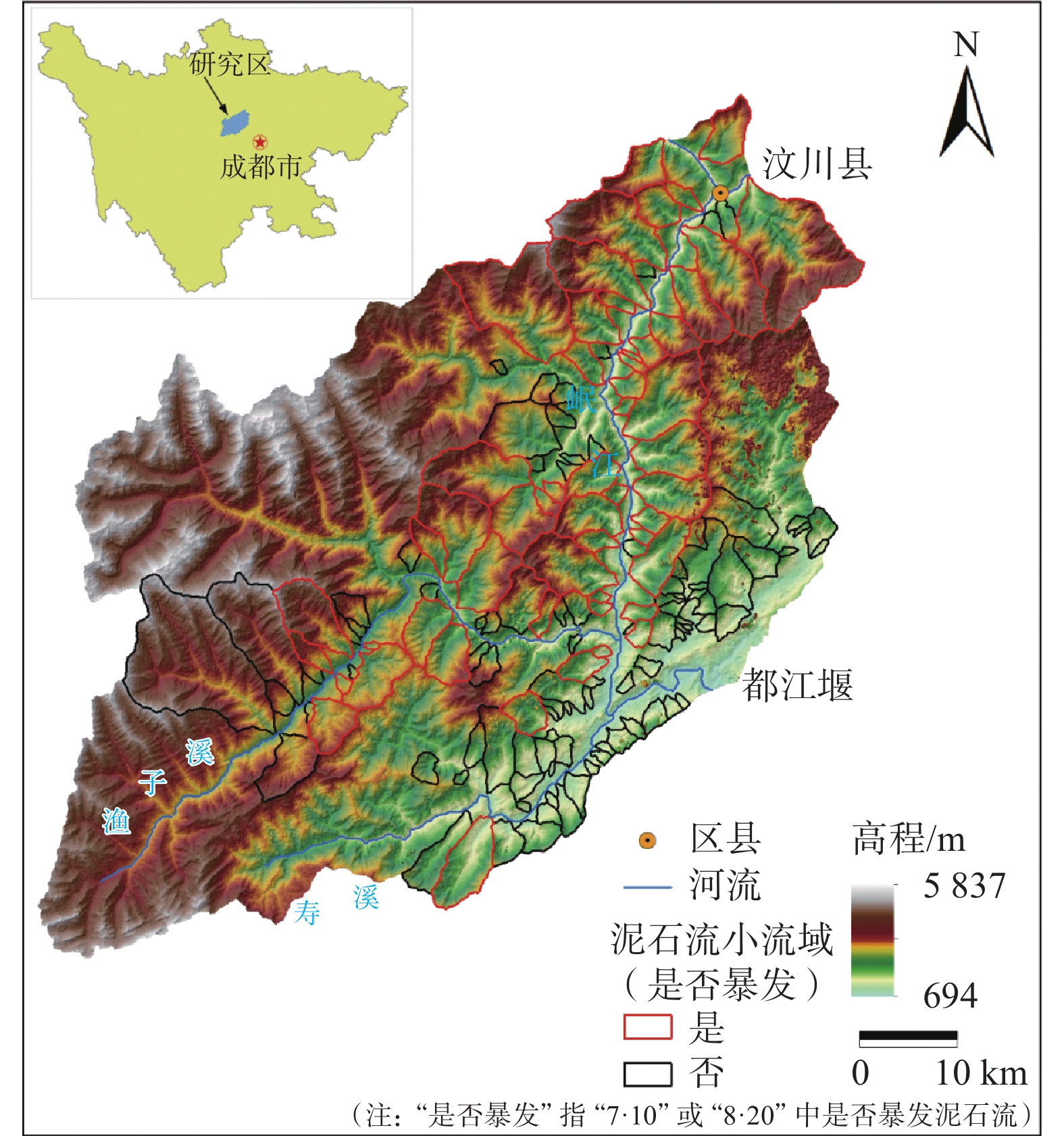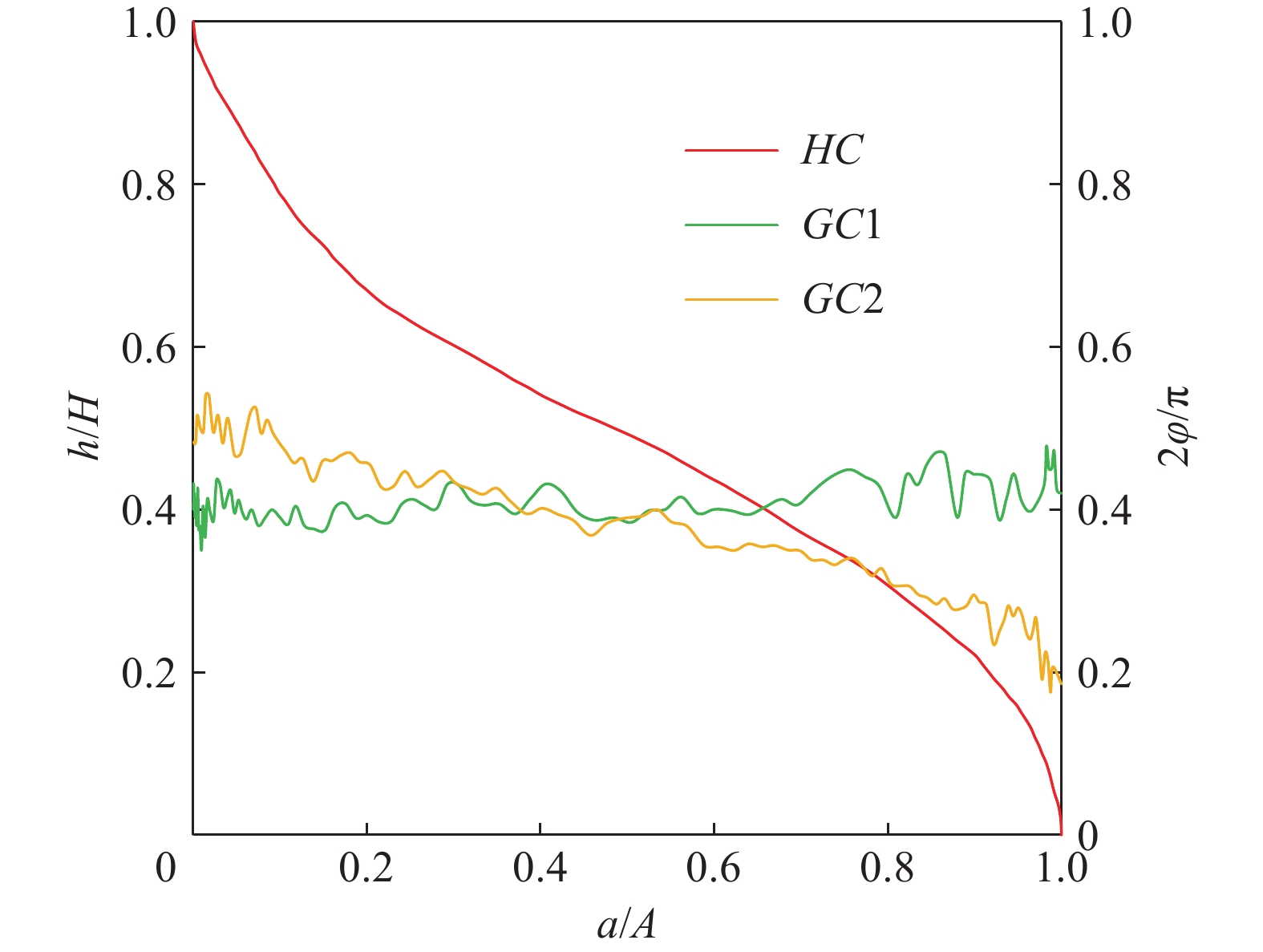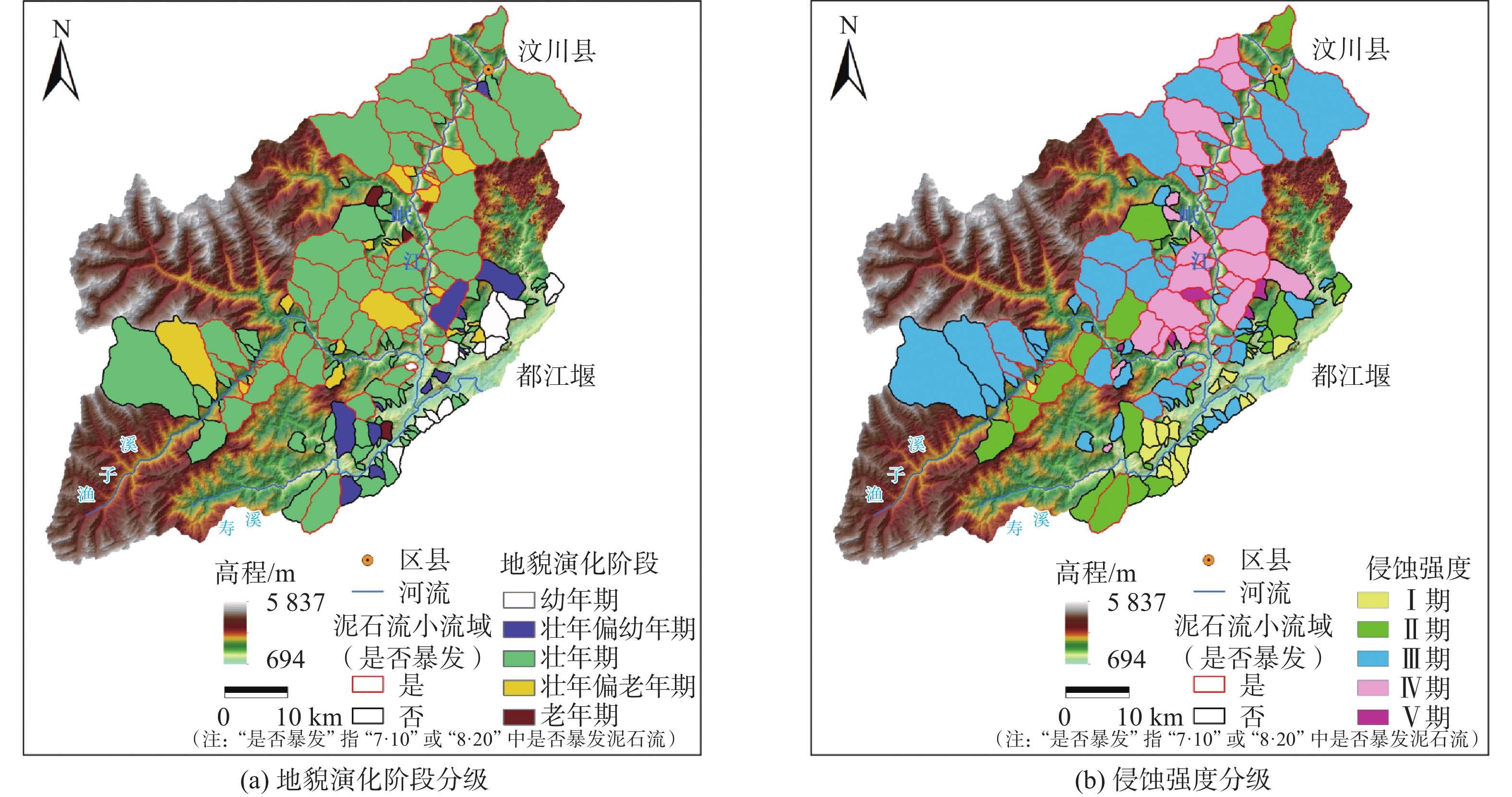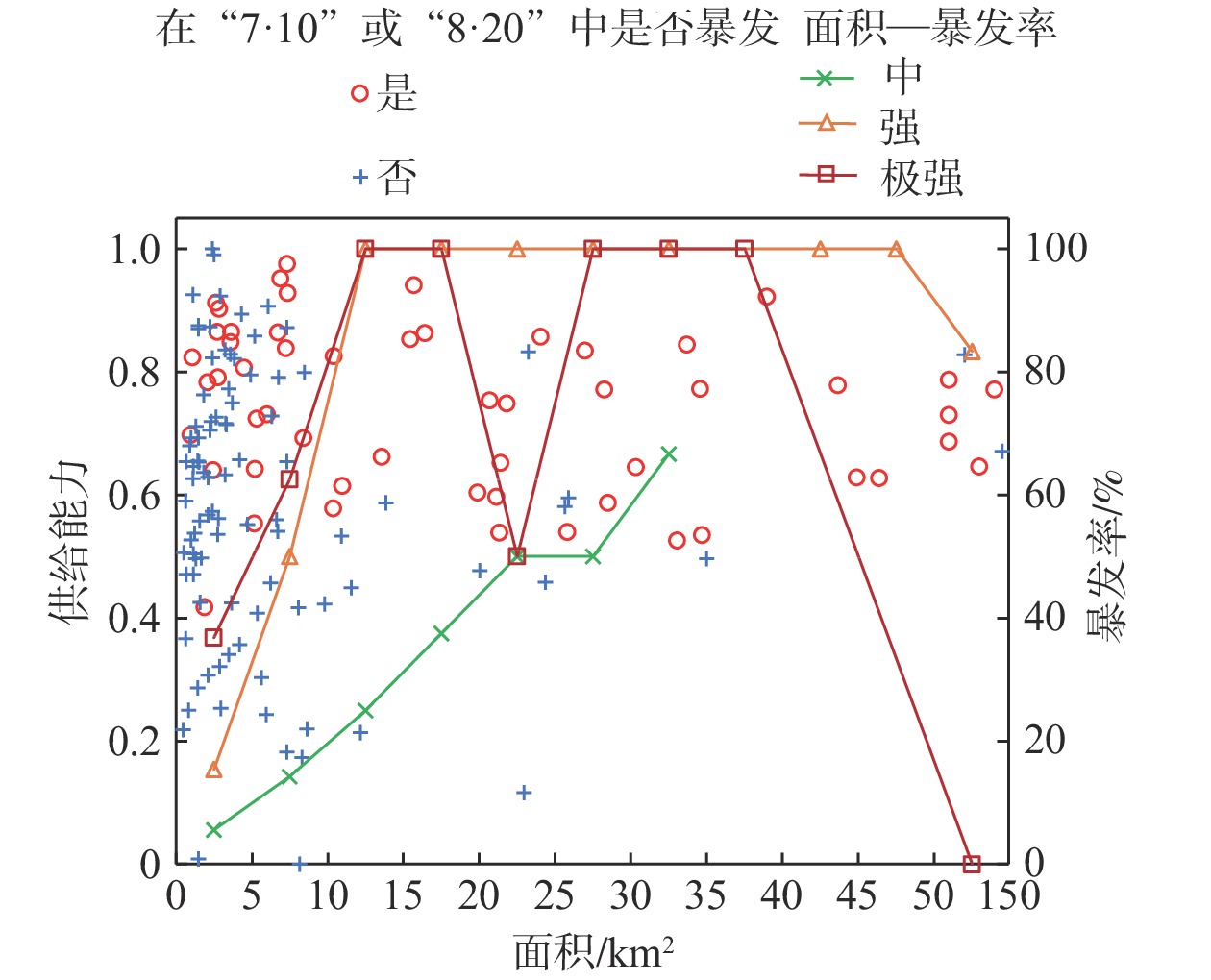The material supply ability analysis of debris flows based on area-hypsometric integral and area-gradient integral
-
摘要:
松散物质是流域侵蚀演化的产物,对于泥石流流域而言,物质供给能力影响着泥石流的易发程度和活动频率。以岷江上游都江堰—汶川部分区域147个泥石流小流域为例,运用面积−高程法和面积−坡度积分对流域地貌演化阶段和侵蚀强度定量划分,并结合地貌演化阶段和侵蚀强度开展泥石流物质供给能力研究。研究结果表明:采用单一的地貌演化阶段或侵蚀强度解释泥石流的易发程度具有一定局限性,泥石流暴发主要集中于壮年期、壮年偏幼年期及侵蚀强度Ⅲ~Ⅴ级;随着物质供给能力的提升,泥石流的暴发率上升,而面积对泥石流的暴发有一定限制作用,初步确定研究区内供给能力处中、强、极强三种水平泥石流流域,其优势发育面积范围分别为:20~35 km2、10~50 km2、10~40 km2;对于物质供给能力水平较高、面积处于优势发育范围内、且长期未有明显泥石流活动迹象的流域,应进一步排查流域松散物质储量和分布特征,确定泥石流活动稳定性,采取合理的防灾减灾措施。
Abstract:The loose material is produced by erosion and evolution of basins. The material supply ability affects the susceptibility degree and activity frequency of debris flow for debris flow basins. Taking 147 debris flow basins as a case, located in parts of Dujiangyan and Wenchuan, using the area-hypsometric integral and the area-gradient integral, the geomorphologic evolution stage and erosion intensity were quantified. Combined with the geomorphologic evolution stage and erosion intensity, the material supply ability analysis of debris flows was carried out. The results are as follows: it is not enough to explain the susceptibility degree only with the geomorphologic evolution stage or erosion intensity; the outbreaks of debris flow are mainly concentrating on the stage of maturity, maturity partial youth age and the erosion intensity Ⅲ—Ⅴ level; with the improvement of the material supply ability, the outbreak rate of debris flow increases, and the basin area plays a significant role in limiting the formation of debris flow; for medium, strong, and extremely strong supply ability levels, debris flow preponderant development area ranges are: 20—35, 10—50, 10—40 km2 respectively, in the study area; the investigation of material reserve and distribution should be carried out on the basin, which with a high level of material supply ability and in the optimal range of area and with unapparent debris flow activity for a long time, to confirm the stability of debris flow and formulate disaster control plans reasonably.
-
Key words:
- debris flow /
- area-hypsometric integral /
- erosion intensity /
- material supply ability
-

-
表 1 各地貌阶段分级与泥石流暴发情况
Table 1. The outbreaks of debris flow and evolution stages
地貌阶段分级 流域数量 暴发数量 暴发率/% 幼年期 4 1 25.00 壮年偏幼年期 19 7 36.84 壮年期 97 44 45.36 壮年偏老年期 13 1 7.69 老年期 14 1 7.14 表 2 侵蚀强度分级与泥石流暴发情况
Table 2. The erosion intensity and outbreaks of debris flow
侵蚀强度分级 流域数量 暴发数量 暴发率/% Ⅰ级 19 1 5.26 Ⅱ级 34 6 17.65 Ⅲ级 61 28 45.90 Ⅳ级 28 18 64.29 Ⅴ级 5 1 20.00 表 3 流域供给能力分级与泥石流暴发情况
Table 3. Material supply ability and debris flow outbreaks
供给能力分级 流域数量 暴发数量 暴发率/% 极弱 5 0 0 弱 13 0 0 中 40 9 22.50 强 52 25 48.08 极强 37 20 54.05 -
[1] DAVIS W M. The geographical cycle[J]. Geographical Journal,1899,14(5):481 − 504. doi: 10.2307/1774538
[2] STRAHLER A N. Hypsometric (area-altitude) analysis of erosional topography[J]. Geological Society of America Bulletin,1952,63(11):1117 − 1142. doi: 10.1130/0016-7606(1952)63[1117:HAAOET]2.0.CO;2
[3] LUO W. Quantifying groundwater-sapping landforms with a hypsometric technique[J]. Journal of Geophysical Research-Planets,2000,105(E1):1685 − 1694. doi: 10.1029/1999JE001096
[4] COHEN S, WILLGOOSE G, HANCOCK G. A methodology for calculating the spatial distribution of the area-slope equation and the hypsometric integral within a catchment[J]. Journal of Geophysical Research-Earth Surface,2008,113(F3).
[5] RABII F, ACHOUR H, REBAI N, et al. Hypsometric integral for the identification of neotectonic and lithology differences in low tectonically active area (Utica-Mateur region, north-eastern Tunisia)[J]. Geocarto International,2017,32(11):1229 − 1242. doi: 10.1080/10106049.2016.1195890
[6] SHI Z H, HUANG X D, AI L, et al. Quantitative analysis of factors controlling sediment yield in mountainous watersheds[J]. Geomorphology,2014,226:193 − 201. doi: 10.1016/j.geomorph.2014.08.012
[7] SORIA-JAUREGUI A, JIMENEZ-CANTIZANO F, ANTON L. Geomorphic and tectonic implications of the endorheic to exorheic transition of the Ebro River system in northeast Iberia[J]. Quaternary Research,2019,91(2):472 − 492. doi: 10.1017/qua.2018.87
[8] CHEN C Y, WANG Q. Debris flow-induced topographic changes: effects of recurrent debris flow initiation[J]. Environmental Monitoring and Assessment,2017,189(9):449. doi: 10.1007/s10661-017-6169-y
[9] CUI Y, CHENG D, CHAN D. Investigation of Post-Fire debris flows in montecito[J]. Isprs International Journal of Geo-Information,2019,8(1):5.
[10] 黄江成, 欧国强, 潘华利. 白龙江与小江泥石流流域地貌演化比较分析[J]. 中国地质灾害与防治学报,2014,25(1):6 − 11. [HUANG Jiangcheng, OU Guoqiang, PAN Huali. Geomorphic evolution of comparison on debris flow gullies in Bailongjiang and Xiaojiang basins[J]. The Chinese Journal of Geological Hazard and Control,2014,25(1):6 − 11. (in Chinese with English abstract)
[11] 国家防汛抗旱总指挥部办公室, 中国科学院水利部成都山地灾害与环境研究所. 山洪泥石流滑坡灾害及防治[M]. 北京: 科学出版社, 1994: 88-92.
The Office of the State Flood Control and Drought Relief Headquarters, Chengdu Institute of Mountain Hazards and Environment, Chinese Academy of Sciences and Ministry of Water Conservancy. Landslide debris flow disasters and prevention[M]. Beijing: Science Press, 1994: 88-92. (in Chinese)
[12] 王雷, 吴君平, 赵冰雪, 等. 基于GIS和信息量模型的安徽池州地质灾害易发性评价[J]. 中国地质灾害与防治学报,2020,31(3):96 − 103. [WANG Lei, WU Junping, ZHAO Bingxue, et al. Susceptibility assessment of geohazards in Chizhou City of Anhui Province based on GIS and informative model[J]. The Chinese Journal of Geological Hazard and Control,2020,31(3):96 − 103. (in Chinese with English abstract)
[13] 刘云, 康卉君. 江西崩塌滑坡泥石流灾害空间时间分布特征分析[J]. 中国地质灾害与防治学报,2020,31(4):107 − 112. [LIU Yun, KANG Huijun. Spatial-temporal distribution of landslide,rockfall and debris flow hazards in Jiangxi Province[J]. The Chinese Journal of Geological Hazard and Control,2020,31(4):107 − 112. (in Chinese with English abstract)
[14] 朱渊, 余斌, 亓星, 等. 地形条件对泥石流发育的影响—以岷江流域上游为例[J]. 吉林大学学报(地球科学版),2014,44(1):268 − 277. [ZHU Yuan, YU Bin, QI Xing, et al. Topographical factors in the formation of gully type debris flows in the upper reaches of Minjiang River[J]. Journal of Jilin University(Earth Science Edition),2014,44(1):268 − 277. (in Chinese with English abstract)
[15] 刘德玉, 贾贵义, 李松, 等. 地形因素对白龙江流域甘肃段泥石流灾害的影响及权重分析[J]. 水文地质工程地质,2019,46(3):33 − 39. [LIU Deyu, JIA Guiyi, LI Song, et al. Impacts of topographical factors on debris flows and weight analysis at the Gansu segment of the Bailongjiang River Basin[J]. Hydrogeology & Engineering Geology,2019,46(3):33 − 39. (in Chinese with English abstract)
[16] 黄成, 张友谊, 眭静, 等. 地形因子对沟谷泥石流发育的影响—以都汶高速“7.10”群发泥石流为例[J]. 人民长江,2019,50(8):115 − 119. [HUANG Cheng, ZHANG Youyi, SUI Jing, et al. Influence of topographic factors on valley debris flow development: case of “7.10” cluster debris flows in Duwen expressway[J]. Yangtze River,2019,50(8):115 − 119. (in Chinese with English abstract)
[17] 曹晨, 余斌, 马二龙, 等. 四川汶川县佛堂坝沟“7·10”泥石流调查研究[J]. 泥沙研究,2019,44(1):38 − 43. [CAO Chen, YU Bin, MA Erlong, et al. Study on debris flow in Fongtuba gully after the earthquake at Wenchuan County of Sichuan Province[J]. Journal of Sediment Research,2019,44(1):38 − 43. (in Chinese with English abstract)
[18] 孔应德, 郭晓军, 邹强, 等. 汶川县古溪沟“7·10”泥石流形成特征及防治工程的影响[J]. 山地学报,2014,32(3):320 − 326. [KONG Yingde, GUO Xiaojun, ZOU Qiang, et al. Giant debris flow hazards in Guxi gully, Wenchuan County of China on July 10, 2013[J]. Mountain Research,2014,32(3):320 − 326. (in Chinese with English abstract) doi: 10.3969/j.issn.1008-2786.2014.03.009
[19] 严炎, 葛永刚, 张建强, 等. 四川省汶川县簇头沟“7·10”泥石流灾害成因与特征分析[J]. 灾害学,2014,29(3):229 − 234. [YAN Yan, GE Yonggang, ZHANG Jianqiang, et al. Research on the debris flow hazards in Cutou Gully, Wenchuan County on July 10, 2013[J]. Journal of Catastrophology,2014,29(3):229 − 234. (in Chinese with English abstract)
[20] 邹强, 郭晓军, 朱兴华, 等. 岷江上游“7·10”泥石流对公路的危害方式及成因[J]. 山地学报,2014,32(6):747 − 753. [ZOU Qiang, GUO Xiaojun, ZHU Xinghua, et al. Hazard characteristics and causes of “7·10” debris flow along highways in the upper reaches of Minjiang river[J]. Mountain Research,2014,32(6):747 − 753. (in Chinese with English abstract) doi: 10.3969/j.issn.1008-2786.2014.06.014
[21] 伍排勇, 张进春. 汶川干部群众积极自救互助自建—汶川抗击“7·10”特大山洪泥石流灾害纪实[N/OL]. 四川新闻网, 2013-07-15[2020-05-29]. http://scnews.newssc.org/system/2013/07/15/013811796.shtml.
WU Paiyong, ZHANG Jinchun. Wenchuan cadres and the masses to actively self-help and mutual assistance self - Wenchuan fight against “7·10” large debris flow disaster documentary[N/OL]. NEWSSC, 2013-07-15[2020-5-29]. http://scnews.newssc.org/system/2013/07/15/013811796.shtml. (in Chinese)
[22] 刘名洋. 汶川山洪泥石流灾害已致12人遇难, 26人失联[N/OL]. 新京报, 2019-8-23[2020-5-29]. http://www.bjnews.com.cn/news/2019/08/23/618811.html.
LIU Mingyang. Wenchuan torrential debris flows have caused 12 people were killed and 26 people lost contact[N/OL]. The Beijing News, 2019-8-23[2020-5-29]. http://www.bjnews.com.cn/news/2019/08/23/618811.html.(in Chinese)
[23] 刘名洋. 四川阿坝暴雨引发泥石流, 汶川等地多条道路中断[N/OL].新京报, 2019-8-20[2020-5-29]. http://www.bjnews.com.cn/news/2019/08/20/617164.html.
LIU Mingyang. The Beijing News. Heavy rains triggered landslides in Sichuan Aba, Sichuan and other places a number of roads are cut off[N/OL]. The Beijing News, 2019-8-20[2020-5-29]. http://www.bjnews.com.cn/news/2019/08/20/617164.html.(in Chinese)
[24] PIKE R J, WILSON S E. Elevation-relief ratio, hypsometric integral and geomorphic Area-Altitude analysis[J]. Geological Society of America Bulletin,1971,82(4):1079 − 1084. doi: 10.1130/0016-7606(1971)82[1079:ERHIAG]2.0.CO;2
[25] 常直杨, 王建, 白世彪, 等. 面积高程积分值计算方法的比较[J]. 干旱区资源与环境,2015,29(3):171 − 175. [CHANG Zhiyang, WANG Jian, BAI Shibiao, et al. Comparison of hypsometric integral methods[J]. Journal of Arid Land Resources and Environment,2015,29(3):171 − 175. (in Chinese with English abstract)
[26] 王协康, 方铎. 白龙江流域泥石流沟形态非线性研究[J]. 人民长江,1999(5):19 − 21. [WANG Xiekang, FANG Duo. Nonlinear debris flow in Bailong river basin furrow[J]. Yangtze River,1999(5):19 − 21. (in Chinese with English abstract)
[27] 李明威, 唐川, 陈明, 等. 汶川震区北川县泥石流流域崩滑体时空演变特征[J]. 水文地质工程地质,2020,47(3):182 − 190. [LI Mingwei, TANG Chuan, CHEN Ming, et al. Spatio-temporal evolution characteristics of landslides in debris flow catchment in Beichuan County in the Wenchuan earthquake zone[J]. Hydrogeology & Engineering Geology,2020,47(3):182 − 190. (in Chinese with English abstract)
[28] 吕学军, 刘希林, 苏鹏程. 四川达曲河流域泥石流沟发育阶段的面积—高程分析[J]. 山地学报,2005,23(3):336 − 341. [LYU Xuejun, LIU Xilin, SU Pengcheng. The area-altitude analysis on the evolution stage of debris flow ravines:Taking Daqu river as an example[J]. Mountain Research,2005,23(3):336 − 341. (in Chinese with English abstract) doi: 10.3969/j.issn.1008-2786.2005.03.013
[29] 蒋忠信. 滇西北三江河谷纵剖面的发育图式与演化规律[J]. 地理学报,1987,142(1):16 − 27. [JIANG Zhongxin. Model of development and rule of evolution of the longitudinal profiles of the valley of three rivers’ in the northwestern part of Yunnan Province[J]. Acta Geographica Sinica,1987,142(1):16 − 27. (in Chinese with English abstract) doi: 10.3321/j.issn:0375-5444.1987.01.002
[30] 赵岩, 孟兴民, 庆丰, 等. 基于地貌参数的泥石流沟发育阶段划分[J]. 灾害学,2018,33(4):48 − 52. [ZHAO Yan, MENG Xingmin, QING Feng, et al. Stage division of debris flow torrent based on geomorphologic parameter[J]. Journal of Catastrophology,2018,33(4):48 − 52. (in Chinese with English abstract) doi: 10.3969/j.issn.1000-811X.2018.04.010
-




 下载:
下载:



